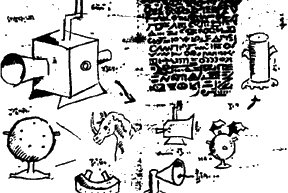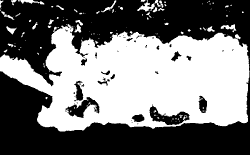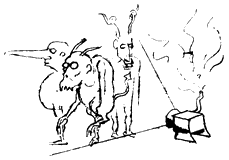Abd-el-Kamir
does not describe the camera obscura, unlike his contemporary, Merlin. Nevertheless,
he gives a recipe of how to prepare a light-sensitive emulsion. Photographic
film, which is now so familiar to us, is obtained by coating an acetate
with a fine layer of gelatin mixed with silver bromide. The formula to prepare
it was discovered in the modern age at the end of the XIX century. However,
one thousand years before, it was known by the Arabian alchemist.
There is no evidence that Abd-el-Kamir knew of the existence
of the camera obscura, nor that Merlin used a sensitive emulsion. In the
Arab's case, he used his chemical discovery, centuries before the Englishman
Talbot, to fix the contours of plants and fruits on a metallic plate by
means of solar light.
After Abd-el-Kamir and for the next 500 years, all trace is lost of possible
research that could have been carried out on the camera obscura and the
alchemy of images.
It is not until the XI century that the investigations mentioned
before are renewed, with the alchemist Adojuhr who lived in Seville during
the reign of Abbad III. In comparison to his predecessors, Adojuhr left
quite a few references on his experiments. His case is exceptional, as
he was the first to combine the camera obscura–a magical camera according
to him–with an extraordinarily sensitive emulsion, which allowed
him to imprint moving images, even without a lens.
If in the case of Merlin and Tzung Ching Pung the references
to the Unicorn are vague, in Adojuhr's case the opposite is true, as he
makes a detailed and thorough description of this animal. He also points
out the usefulness of the horn in each one of the different species for
the perforation of the "lens" of the "magical boxes".
However, he does not give details as to why the Unicorn
should be used in this process. Adojuhr creates infinite diagrams of designs
for the magical boxes and indicates their uses. If we translate, so to
say, the terms that he used, we will see that they are similar to those
used nowadays in the naming of modern photographic lenses.
In his series of recommendations on the chemical compounds
used to capture images, it is not difficult to find the similarity between
them and the present day ones. For example, the iridescent crystal from
Androstián (?) has the sensitive film as an equivalent, the red clay from
Baltur refers perhaps to ammonia dichromate, and so on.
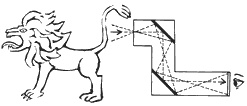
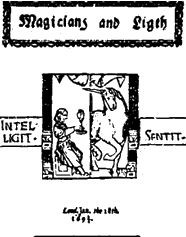
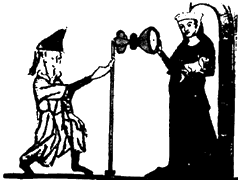
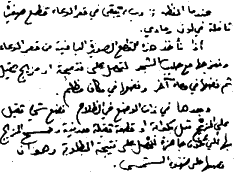 "When
silver is melted, some small lead-colored particles remain at the bottom
of the recipient. If these particles are taken and mixed with animal resin,
a thick solution will be obtained which must be poured into a recipient
where light does not penetrate.
"When
silver is melted, some small lead-colored particles remain at the bottom
of the recipient. If these particles are taken and mixed with animal resin,
a thick solution will be obtained which must be poured into a recipient
where light does not penetrate.